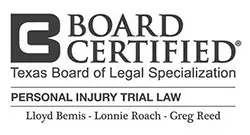Paralysis and Qualifying for SS Disability Benefits
Can I get disability benefits if I am suffering from the effects of Paralysis?
Author: Attorney Greg Reed
Updated: 2/26/2024

The SSA recognizes several disabling diseases that cause paralysis such as brain tumors, cerebral palsy, stroke and muscular dystrophy. Paralysis which occurs as the result of trauma to the brain or spine, such as a serious car accident, is included in this listing. Call 512-454-4000 for help today.
To be eligible for Social Security Disability benefits, an applicant must be able to identify the underlying cause of paralysis and provide medical evidence that paralysis prevents them from working for at least one year.
In 2013 study, researchers found that approximately 1.7 percent of the American population were living with some type of paralysis.
Paralysis is the temporary or permanent loss of muscle function in any part of the body. When a specific part of the body such as an arm or leg is affected, it is described as localized; when a large section of the body is affected, it is called generalized. Though paralysis usually affects an entire body region, paralysis can attack any part of the body at any time. A person may lose the ability to talk or breathe unaided as well as the ability to move.
Symptoms of paralysis depend on the cause of the paralysis and the part(s) of the body affected.
Loss of feeling and movement may be immediate when a stroke occurs, but in other cases, muscle weakness gradually increases. Paralysis can affect nerves carrying sensory information and nerves controlling the heart, lungs, glands, and intestines. Damage to the brain that results in paralysis can affect speech, behavior, and cognitive ability. Other symptoms include numbness and tingling, pain, changes in vision, or problems with balance.
These or a combination of these symptoms can cause you to miss work and jeopardize your ability to maintain employment.
At this time there is no cure for permanent paralysis.
Treatment focuses on assisting the individual in adapting to their condition and helping them become as independent as possible. A variety of mobility aids are now available including manual and electric wheelchairs and braces designed to improve muscle function and compensate for weakness.
Demonstrating that you are following your doctor’s treatment plan is an important part of qualifying for disability benefits.
Paralysis and Qualifying for Disability Benefits.
While some people with paralysis have severe limitations, others do have some abilities.
The severity of paralysis and how it affects an individual and their job duties will determine whether a person can continue working. If an applicant can use their arms or hands, but cannot walk or stand, they may still be able to perform some type of sedentary work. But if a person has lost the use of an arm and a leg and has difficulty balancing, they most likely cannot hold a job.
Though there is no specific listing for paralysis in Social Security’s Blue Book, Social Security recognizes several disorders that may cause paralysis.
- Section 1.04 – Disorders of the spine
- Section 11.08 – Spinal cord disorders
- Section 11.09 – Multiple Sclerosis
- Section 13.13 – Malignant neoplastic disease (Nervous System – brain and spinal cord)
- Section 14.02 – Systemic lupus erythematosus
To be eligible for Social Security Disability benefits, an applicant must be able to identify the underlying cause of paralysis and provide medical evidence that paralysis prevents them from working for at least one year.
The best way to achieve this is to match your medical condition to one of Social Security’s impairment listings.
For example, if your paralysis is caused by a spinal cord disorder (Section 11.08), you must be able to show one of the following to satisfy the requirements of this listing:
- Complete loss of function of any part of the body, such as an arm or leg, as a result of spinal cord injury. (Loss of function can also mean paralysis of the gastrointestinal tract or loss of bladder control).
- Abnormal movement ability in two extremities that is related to a spinal cord injury. For example, one arm and one leg, that causes difficulty in the ability to balance while walking or standing, standing from a seated position, or using the hands and/or arms that is related to a spinal cord problem.
- Evidence of a spinal cord problem that is not severe, but occurring in combination with other serious limitations in 1) understanding, remembering or using information, 2) social interactions, 3) concentration, persisting, maintaining pace, or 4) care of oneself.
Social Security is primarily interested in the severity of loss of function resulting from paralysis and how long it will last.
Regardless of the cause of paralysis, you will need to provide solid medical evidence and substantiating documentation to prove the severity of your paralysis and how it affects your daily functions and your ability to work, including:
- A full medical history
- Test results that identify the cause of paralysis such as MRIs and CT scans
- Doctors’ statements, notes and opinions detailing your medical condition, symptoms, limitations, and prognosis
- Treatment records including medications, surgery, physical therapy, and results of treatment.
Be sure your medical evidence includes any difficulty you have in standing, walking, balancing, getting up from a seated position or using your arms and hands.
If you cannot walk for at least two hours daily, you may be approved for disability benefit.
If your disability does not match any Social Security’s listing, you may still be eligible for Social Security Disability benefits if you have another impairment; for example, high blood pressure or diabetes.
Applicants often have more than one illness or injury that prevents them from working full time. By itself one disorder may not meet the requirements of an impairment as stated in Social Security’s Blue Book. However, if an applicant has multiple medical conditions, Social Security must consider how those health issues, combined together, limit an applicant’s ability to hold a job and perform necessary daily tasks. Social Security will also evaluate how your limitations affect your ability to work, taking into account whether or not you are able to drive, your age, and your level of education. If you can prove that your functional capacity is diminished by paralysis and you are unable to perform your job duties in your previous employment or any other job for which you are qualified, you may be approved for a medical vocational allowance.
If you are 55 or older or have another medical condition you may get approval.
Social Security follows a set of rules to determine when the agency expects an applicant to learn a new job.
Applicants who are 55 or older often fall under a grid rule, which means they are not expected to learn a new job. For example, a 55-year-old applicant with no transferable skills might be found disabled. If you can’t go back to your old job, and you don’t have the skills to learn a new one, Social Security will likely grant you disability benefits.
Social Security also has basic financial requirements.
Before you are eligible for Social Security disability benefits, you must satisfy some basic financial requirements.
You must: 1) have a disability that has lasted or is expected to last 12 months; and 2) you must have worked in a job where you paid Social Security taxes long enough and recently enough; and 3) you must not earn more than Substantial Gainful Activity (SGA), which is $1,550 per month in 2024 for nonblind applicants and $2,590 per month for blind applicants.
What if I don’t qualify for SSDI?
If you haven’t worked long enough to earn enough work credits, or if you earn too much income, you may be eligible for disability benefits through another Social Security program, such as Supplemental Security Income (SSI), or from a long-term disability insurance plan through your employer or a privately purchased policy.
SSI is a program that pays monthly benefits to people with limited income and resources who are disabled, blind, or age 65 or older. SSI is based on income instead of work credits, and is financed by general funds of the U.S. Treasury.
I have long-term disability insurance – should I file a claim?
Yes, you should file a claim as soon as you become disabled.
Long-term disability insurance (LTD) is coverage that protects your income if you are unable to work due to illness or injury and is purchased as part of a group employment plan or privately through an insurance company. Policies pay between 50-60% of your salary and benefits continue until you return to work or for the number of years stated in the policy. However, LTD coverage is good only as long as you are employed, so do not quit your job before you file a claim, and be sure to check your policy’s definition of “disabled” as each policy will state the definition of “disabled” which is in use. Additionally, be aware that long-term disability insurance companies can require a claimant to also apply for SSDI.
How do I file for Social Security Disability benefits?
You can apply for Social Security Disability benefits online, over the phone, or in person at your local Social Security Administration office.
If your initial application is denied, don’t be discouraged. Approximately 65% of initial applications are denied, but you will have the opportunity to appeal.
There are four steps to the Social Security appeal process:
- File a Request for Reconsideration with the Social Security Administration to completely review the case.
- If you don’t agree with SSA’s response to your Request for Reconsideration, you can request a hearing before an Administrative Law Judge (ALJ). ALJs are attorneys who work for the Social Security Administration; they review SSDI cases and either uphold or overturn decisions to deny SSDI benefits. If you are not represented by an attorney at this point, now is the time to obtain legal counsel. This is a critical point in the process and will raise your chance for success.
- If an ALJ does not grant your claim, you can request that the Appeals Council review your case.
- Federal Court review. The final step in the appeal process is filing suit in U.S. District Court.
If you are suffering from the effects of Paralysis and have been denied disability don’t give up, almost 70% are denied initially! Just call 512-454-4000 for a free, no obligation consultation to learn what your options are. Have some questions? just give us a call, we love to help folks just like you!
Do I need a disability attorney for SSDI?
Qualifying for Social Security Disability benefits is problematic because the requirements of Social Security’s impairment listing are very difficult to decipher.
Your chances for approval are increased significantly if you have an experienced disability attorney who can gather your necessary medical evidence and even write a brief explaining why you qualify. At each potential stage of the process, from the initial application stage, the reconsideration stage and the ALJ hearing stage, an attorney can assist you in completing the detailed forms and questionnaires required by Social Security, collecting and submitting relevant medical evidence, and preparing questionnaires for your doctors. At the ALJ hearing phase an attorney will not only continue to assure that the evidence is complete, but prepare you for questioning by the ALJ, prepare an argument on your behalf and question any doctors or vocational experts selected by the ALJ to testify at the hearing. At the Appeals Council and federal court level, a lawyer can present legal arguments to show your case was wrongfully denied. Fees charged by disability attorneys are regulated by federal law and are usually 25% of disability backpay you are owed. There are no out-of-pocket costs, and if you don’t win your case, you won’t be charged anything.
Do I need a disability attorney for a long-term disability insurance claim?
Whether you have a long-term disability insurance policy purchased through a private insurance broker or a group policy purchased with your employer, filing a claim for long-term insurance is a complex process.
The wording of LTD policies can be confusing and the laws and regulations which affect the two types of LTD insurance differ in their procedures for filing claims and appeals. An experienced LTD attorney with thorough knowledge of ERISA laws and regulations will avoid mistakes and increase your chance of success. An attorney will act on your behalf, completing your application and filing your claim in a timely manner. They can also negotiate a settlement or file an appeal for you. If it becomes necessary to file suit, an LTD attorney can prepare your case against an insurer. Most LTD attorneys handle cases on a contingency basis and charge approximately 25%-40% of a claimant’s past due benefits. You do not pay an attorney’s fee unless the attorney wins your case.
Disability benefits are an important source of income for those who are unable to work. If you are not able to work due to accident or illness, you may be eligible for Social Security Disability or Long Term Disability benefits. If you have applied for benefits and been denied, contact the attorneys at Bemis, Roach and Reed for a free consultation. Call 512-454-4000 and get help NOW.
Back Injuries and Social Security Disability Lawyers in Texas
Traumatic Brain Injuries and SSD
Social Security Disability for Stroke Victims
Author: Attorney Greg Reed has been practicing law for 29 years. He is Superlawyers rated by Thomson Reuters and is Top AV Preeminent® and Client Champion Gold rated by Martindale Hubbell. Through his extensive litigation Mr. Reed obtained board certification from the Texas Board of Legal Specialization. Greg is admitted to practice in the United States District Court – all Texas Districts and the United States Court of Appeals-Fifth Circuit. Mr. Reed is a member of the Travis County Bar Association, Texas Trial Lawyers Association, past Director of the Capital Area Trial Lawyers Association, and an Associate member of the American Board of Trial Advocates. Mr. Reed and all the members of Bemis, Roach & Reed have been active participants in the Travis County Lawyer referral service.

![]()
Your Free Initial Consultation
Call now:
At Bemis, Roach and Reed, if we can't help you, we will try to find the right attorneys for you.
We offer each of our prospective clients a free no obligation one hour phone or office consultation to see if we can help you and if you are comfortable with us. We know how difficult a time like this can be and how hard the decisions are. If we can be of assistance to you and help you find a solution to your issue we will even if that means referring you to another attorney.
Let's get you Started:
If you could provide us with some basic information about your claim we will get right back with you with a free case evaluation and schedule your Free Consultation Today.







